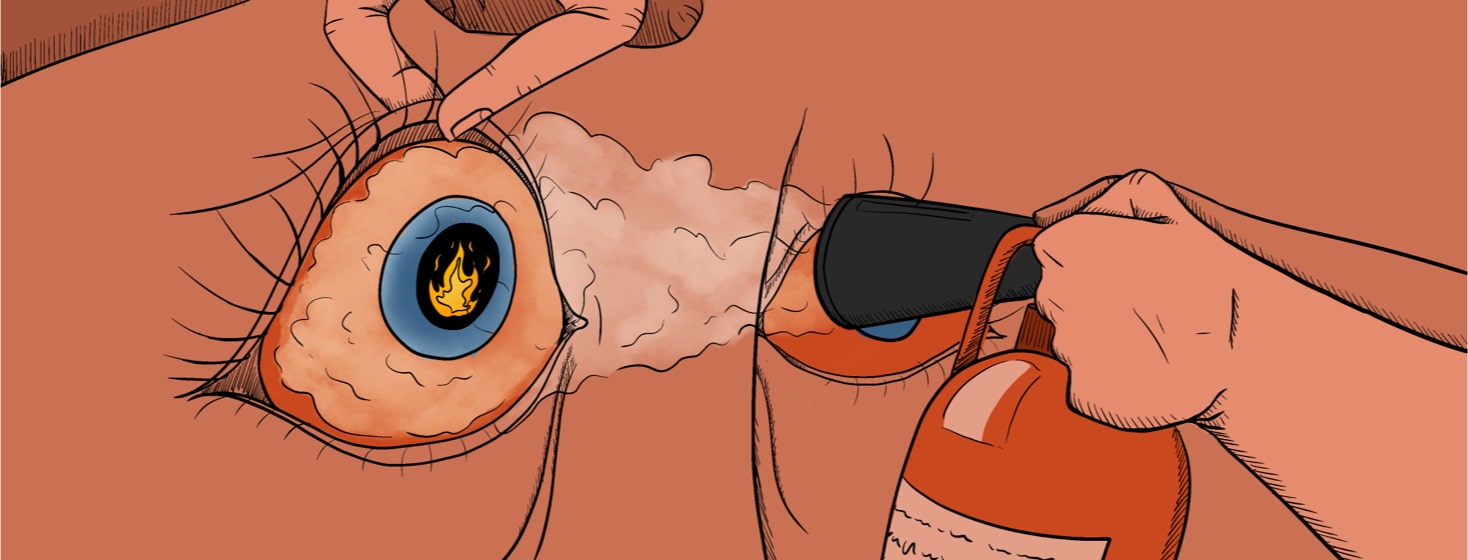Unexpected Red: Eye Inflammation with RA
Until my own episode, I never realized RA could affect your eyes. Joints? Sure. But eyes? It seemed far-fetched in a disease like RA.
I was aware of the need for routine eye exams and the potential eye complications with hydroxychloroquine (Plaquenil). However, no one, not even my rheumatologist, explained eye issues as a possible symptom of RA beyond the side effects of medications. You can imagine how surprised I was when I woke up one morning and had apparent eye inflammation connected to my RA. What were my symptoms? What did I do? What did I learn from this bizarre symptom of RA?
How common are eye issues in RA?
Although eye issues aren’t widely discussed in the RA community, dry eye disease (DED) is relatively common in RA patients, with several other eye conditions occurring less commonly. The most common eye issues include:1
- Dry eye disease (inadequate lubrication of the eye caused by decreased tear production)
- Episcleritis (inflammation leading to acute redness and mild discomfort in one area of the eye)
- Scleritis (inflammation in multiple areas of the eye, usually with more severe symptoms)
- Peripheral ulcerative keratitis (inflammation of the peripheral cornea)
- Anterior uveitis (inflammation of the middle layer of the eye)
Dry eye disease is the most common complaint (18-90% of patients with RA will experience it) but not the most serious. Otherwise, less common but potentially more serious inflammation occurs in episcleritis, scleritis, and uveitis. Studies have reported that 1-6% of RA patients will develop scleritis, and 1-5% will experience episcleritis.1
My eye inflammation experience
A few days after I injected my first biologic, Cimzia, I woke up to nurse my son early in the morning. My eyes would not stay open and felt so heavy and sore. Like most moms of infants, I thought I was just exhausted from the heavy work of motherhood. When I went back to bed and woke up again, my eyes felt swollen and sore both at rest and with movement. I couldn’t look toward light without discomfort, and the whites of my eyes were bloodshot and red. I had never had this happen before and immediately searched Dr. Google. I then wrote a message to my own doctor.
After putting on a pair of sunglasses and adorning my eyes with an ice pack, I found my answer pretty quickly—I was suffering from episcleritis, possibly scleritis, which is the even more severe form.
In my research, I found an article relating the start of an injectable biologic to the onset of an inflammation episode like I was experiencing. As I waited to hear back from my doctor, I took an NSAID, and within 30 minutes, I felt so much improvement in the pain and redness. I continued to take NSAIDS throughout the day, and my symptoms improved significantly. Eventually, my doctor got back to me and instructed me on what to do if the symptoms got worse.
Don’t wait when it comes to your eyes
Bottom line: when it comes to your eyes, don’t wait! Make sure you call your doctor or seek medical treatment, especially if your symptoms are causing issues with your vision. Eye issues can quickly turn serious and permanently put your vision at stake. It’s essential to treat the inflammation promptly and monitor symptoms until the episode resolves. Better safe than sorry!
Have you ever experienced eye issues as a result of RA? Share your experience with us below!

Join the conversation